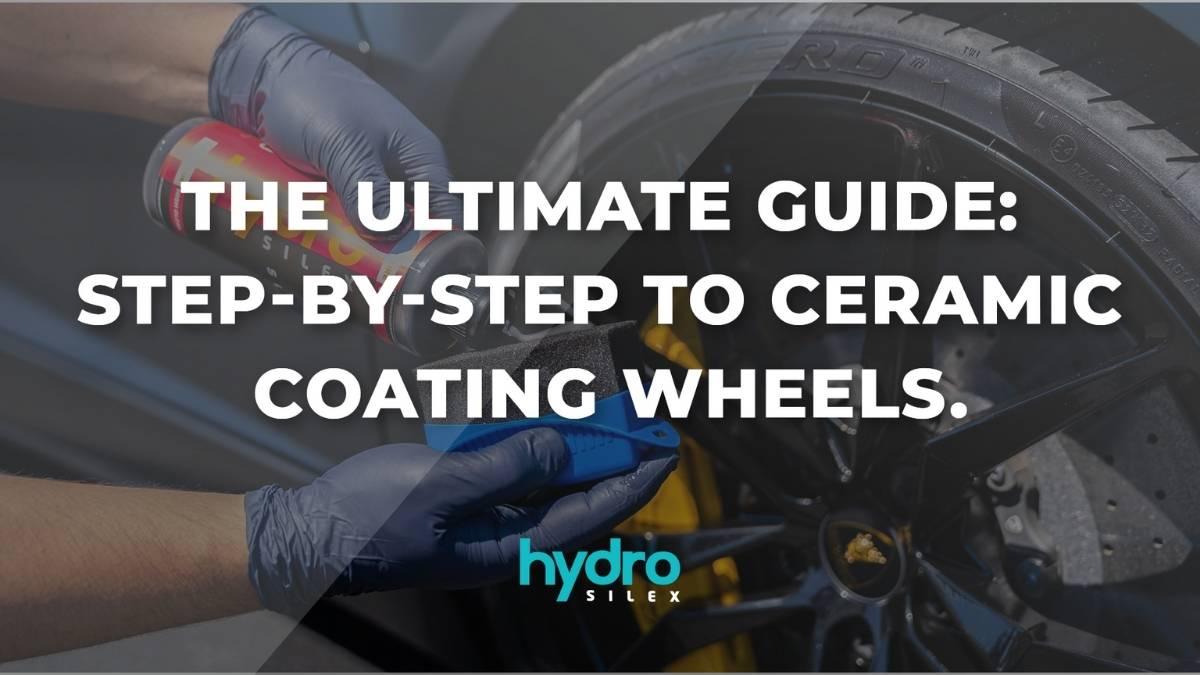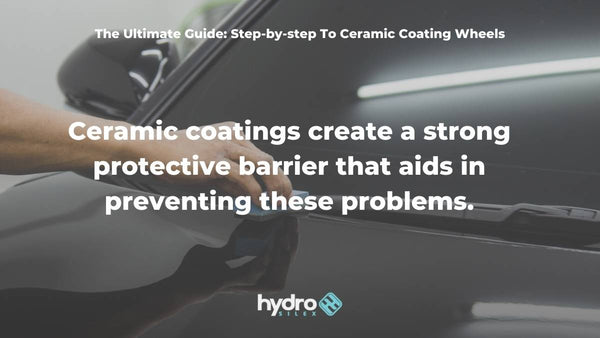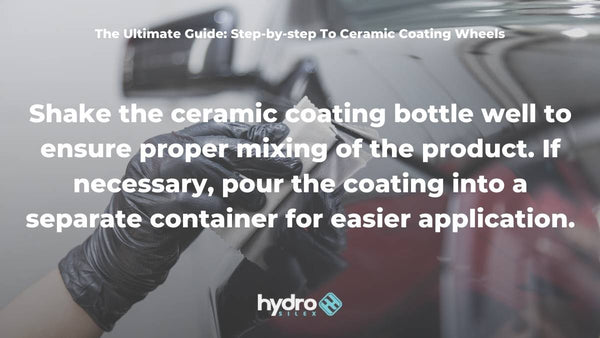The Ultimate Guide: Step-by-step To Ceramic Coating Wheels

Ceramic coating in automotive detailing is not restricted to the vehicle's paintwork. It can also be used on other surfaces, such as wheels. Ceramic wheel coating adds an extra layer of protection against dirt, brake dust, and road pollutants while improving overall appearance.
We will lead you through the step-by-step process of ceramic coating wheels in this blog, presented to you by the specialists at HydroSilex.
What is ceramic coating for wheels?
Ceramic coating for wheels is a protective layer designed explicitly for the rims of a vehicle. It is a liquid polymer that contains ceramic nanoparticles, creating a durable and hydrophobic barrier on the surface of the wheels. The coating bonds with the wheels at a molecular level, forming a protective layer that helps prevent damage from brake dust, road grime, and other contaminants. Ceramic coatings for wheels provide a glossy and slick finish, enhancing the rims' appearance while offering long-lasting protection.
Do we really need to apply ceramic coating to car wheels?
While putting a ceramic coating on car wheels is not required, it does provide several benefits that make it a desirable investment for many car owners. Wheels are continually subjected to adverse environmental conditions such as high temperatures, brake dust, road debris, and caustic compounds. Over time, these variables can cause discoloration, pitting, and deterioration.
Ceramic coatings create a strong protective barrier that aids in preventing these problems. The hydrophobic aspect of the coating repels water and impurities, making cleaning the wheels easier and decreasing brake dust buildup. Furthermore, the coating's slick surface makes it more difficult for dirt and grime to attach to the wheels, keeping them cleaner for longer.

Furthermore, ceramic coatings provide long-term protection, frequently lasting several years. This means less frequent maintenance and maybe lower costs for wheel cleaning supplies. The coating's improved appearance, with its shiny surface, can also contribute to the vehicle's overall aesthetics.
Finally, whether or not to apply ceramic coating to car wheels is a matter of personal preference and priorities. A ceramic coating might be a sensible investment if you value the aesthetic and lifespan of your wheels and the ease of maintenance. It adds an extra layer of protection to your wheels while also improving the overall appearance of your vehicle.
How do you ceramic coat wheels?
Ceramic coating wheels require careful preparation and attention to detail. Follow these step-by-step instructions to achieve optimal results:
Step 1: Clean the Wheels
Start by thoroughly cleaning the wheels to remove dirt, grime, or brake dust. Use a wheel cleaner specifically designed for your wheel type (e.g., alloy, chrome, or painted). Apply the wheel cleaner generously and use a wheel brush or sponge to agitate the surface and remove stubborn contaminants. Rinse the wheels thoroughly with water and dry them completely before moving on to the next step.
Step 2: Decontaminate the Wheels
To ensure a clean and smooth surface for the ceramic coating, it is essential to decontaminate the wheels. Use a dedicated iron fallout remover or wheel decontamination product to remove iron particles and other embedded contaminants. Apply the product to the wheels and allow it to dwell for the recommended time. You may notice the product changing color as it reacts with the iron particles. Rinse the wheels thoroughly and dry them completely.
Step 3: Polish (If Necessary)
Suppose your wheels have any imperfections, such as scratches or swirl marks. In that case, it is advisable to polish them before applying the ceramic coating. Use a suitable wheel polish, foam applicator pad, or polishing machine to restore the wheel's finish. Work on one section at a time, applying the polish in a circular motion. Continue polishing until the desired results are achieved. Wipe off any residue with a clean microfiber cloth.
Step 4: Prepare the Ceramic Coating
Shake the ceramic coating bottle well to ensure proper mixing of the product. If necessary, pour the coating into a separate container for easier application. Some ceramic coatings may require dilution with a specific ratio of water. Follow the manufacturer's instructions carefully.

Step 5: Apply the Ceramic Coating
Using a foam applicator pad or a dedicated wheel coating applicator, apply a thin, even layer of ceramic coating to the wheels. Work on one wheel at a time, ensuring complete coverage. Avoid applying too much product, leading to streaks or uneven curing. Pay extra attention to intricate areas and crevices, ensuring the coating reaches all surfaces. Allow the coating to dwell for the recommended time specified by the manufacturer.
Step 6: Remove Excess Coating
After the recommended dwell time, use a clean and lint-free microfiber cloth to remove any excess coating from the wheels. Gently wipe the surface in straight lines, ensuring a streak-free finish. Inspect the wheels for any missed spots or uneven application. If necessary, apply a second layer of ceramic coating to achieve uniform coverage.
Step 7: Allow Curing Time
The curing time for ceramic coating wheels can vary depending on the product and environmental conditions. In general, it is recommended to allow the coating to cure for at least 24 hours before exposing the wheels to water or other contaminants. Refer to the manufacturer's instructions for specific curing guidelines.
How long does it take to cure?
Depending on the product and climatic conditions, the curing period for ceramic-coated wheels might range from 24 to 72 hours. Temperature, humidity, and ventilation can all impact the curing process. Allow enough drying time to ensure the ceramic coating makes a solid bond with the wheel surface. Avoid exposing the wheels to water, chemicals, or high heat during curing.
Finally, ceramic coating wheels give an extra layer of protection while also improving the overall aesthetic of your vehicle. You may successfully ceramic coat your wheels and enjoy the benefits of long-lasting durability and ease of maintenance by following the step-by-step approach above. Use a high-quality ceramic coating product like HydroSilex for the greatest results. Take your wheel protection to the next level and enjoy your wheels' flawless appearance for years.
HydroSilex is a one stop shop for all the best car detailing products on the market. We have many years of experience in forming high-quality products to help car owners maintain their vehicles. Visit our website at https://www.hydrosilex.com to choose the best cleaning solutions, products and tools for your vehicle.






